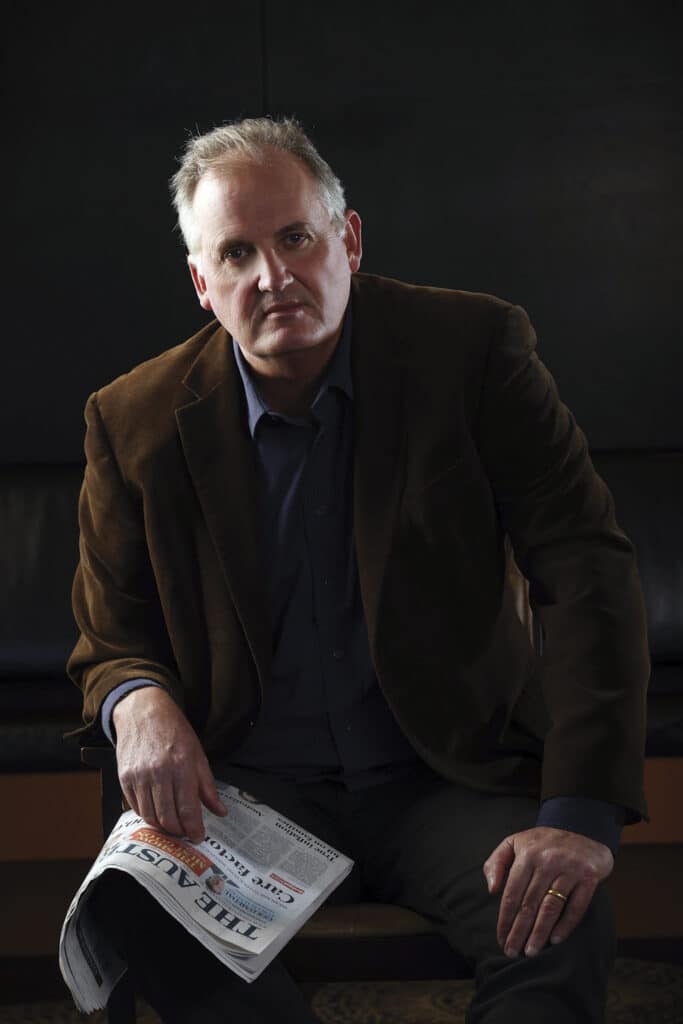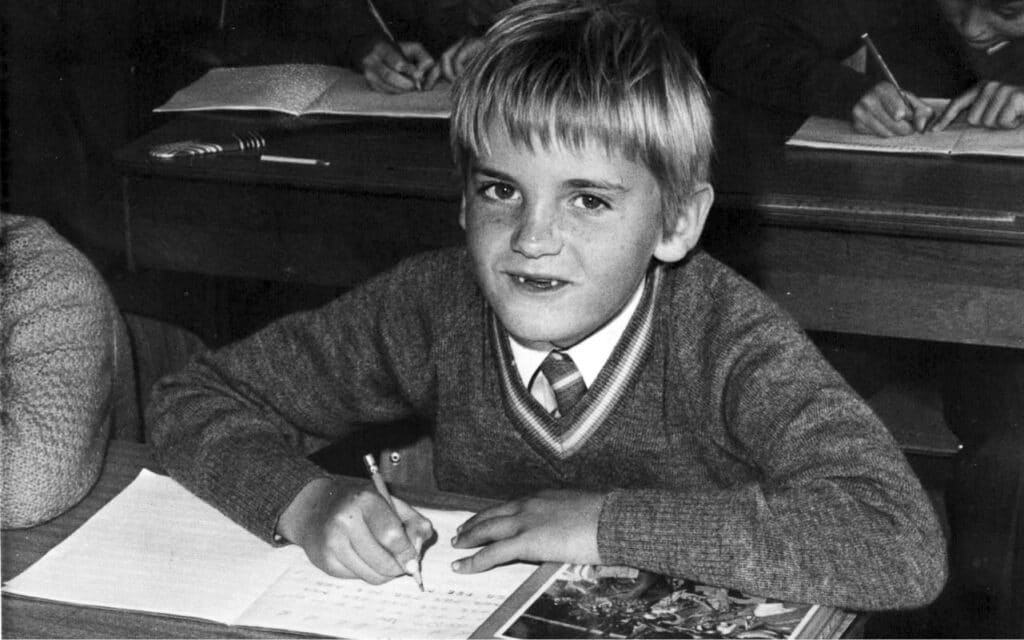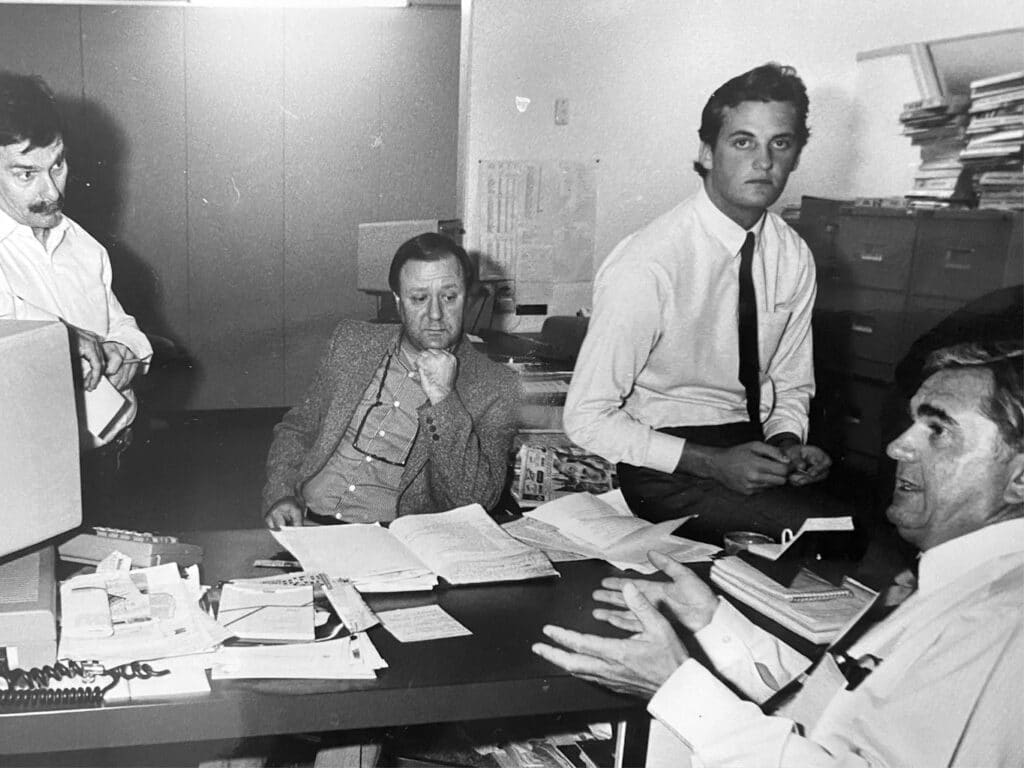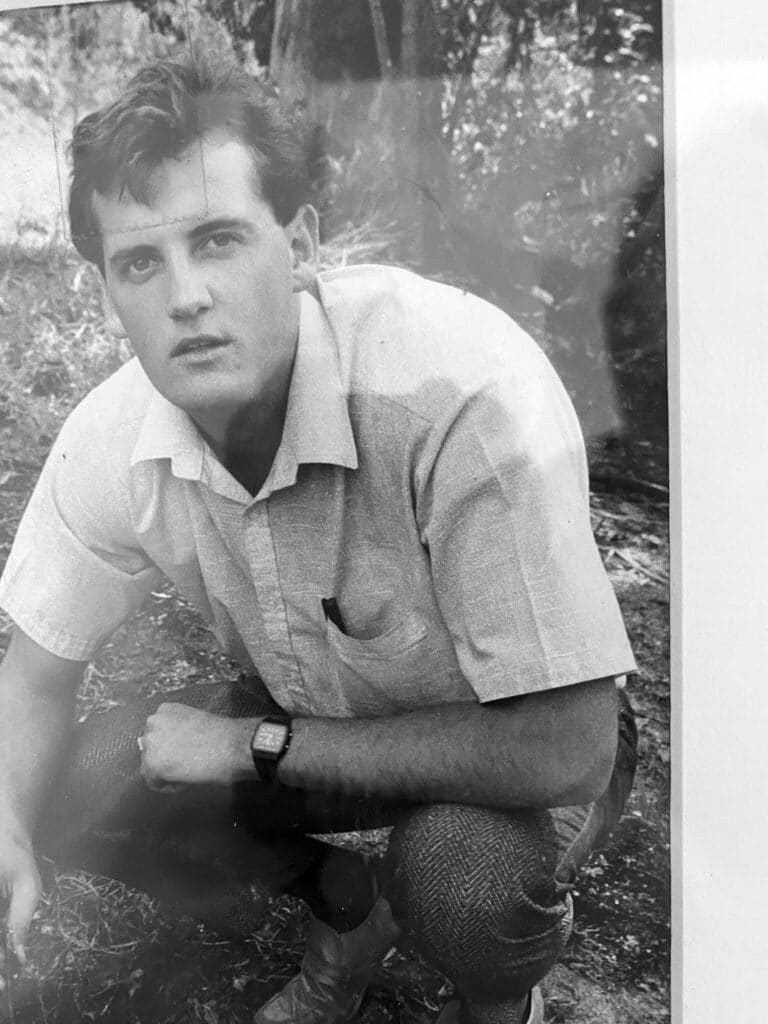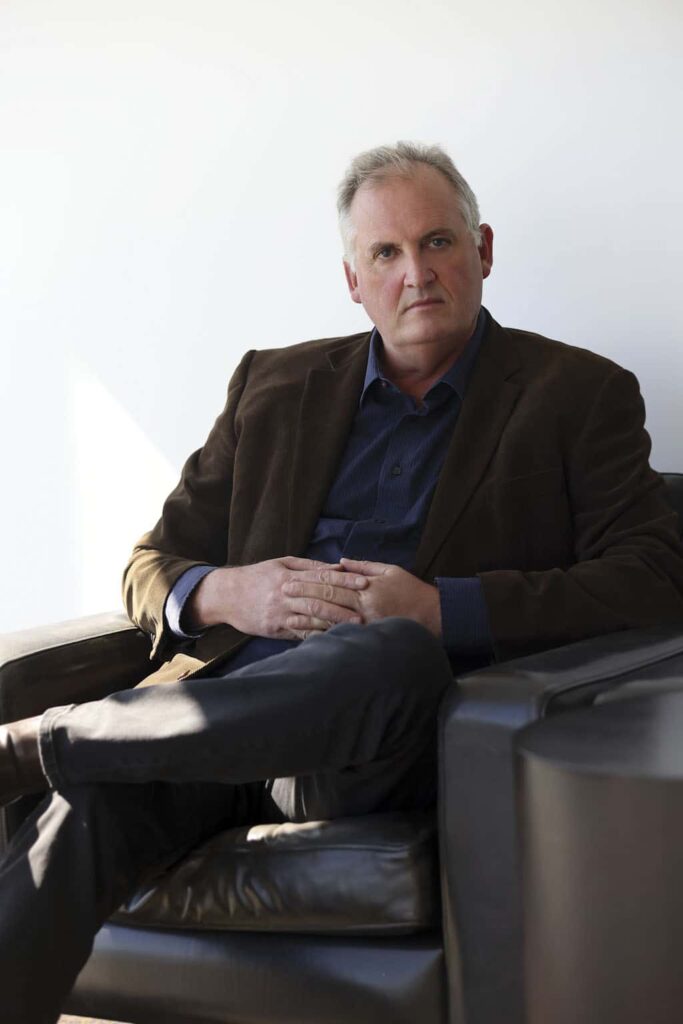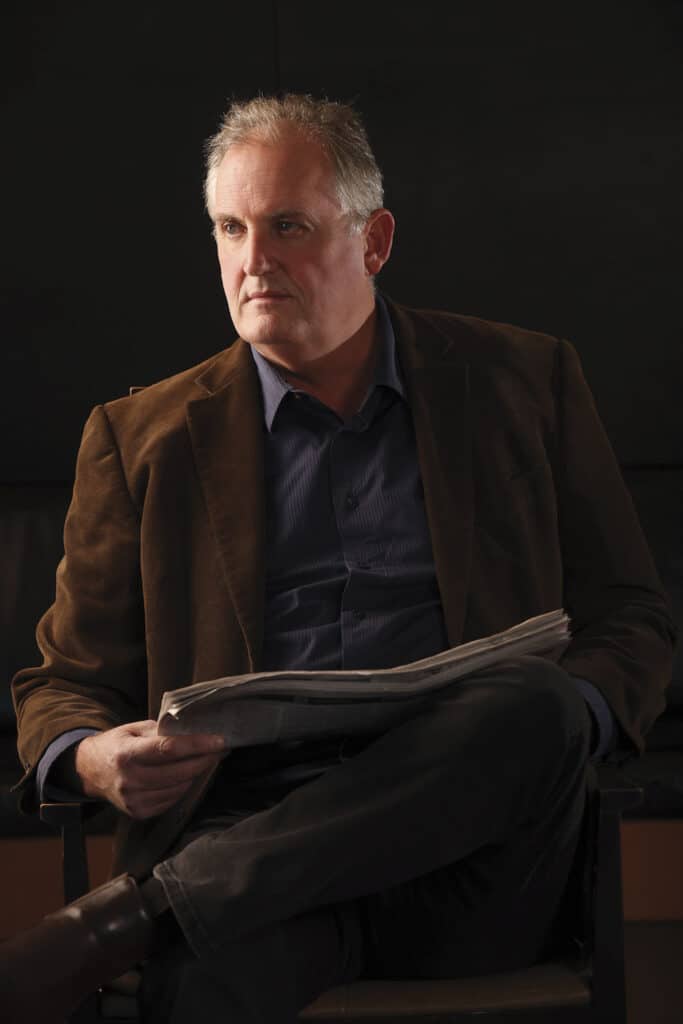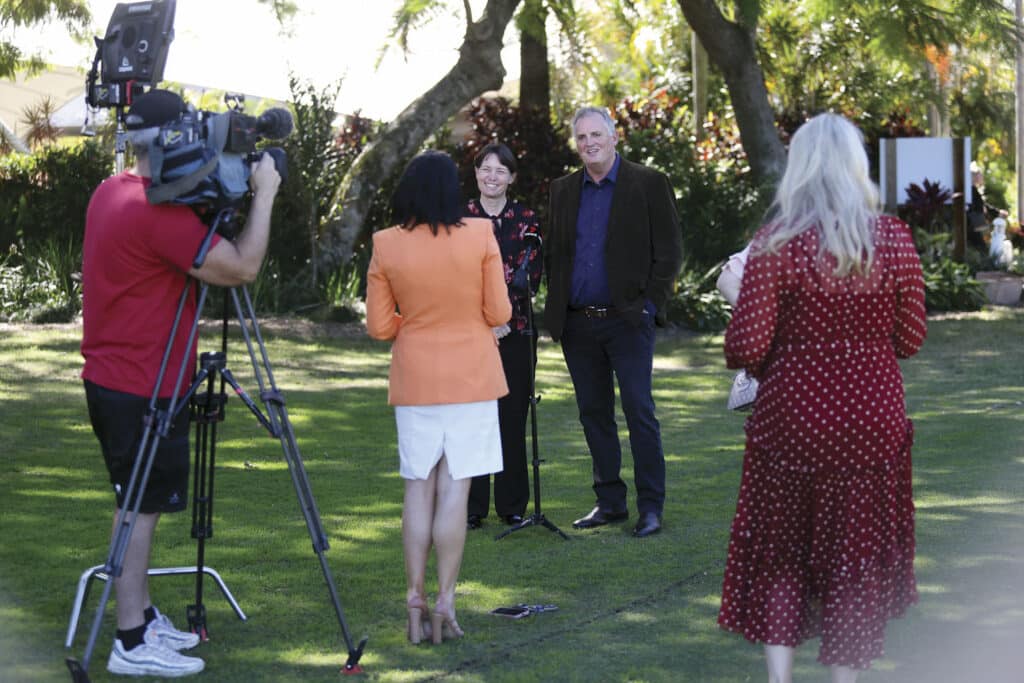COVER STORY
THE NEWSPAPERMAN – How a kid from the Gold Coast became one of Australia’s finest reporters
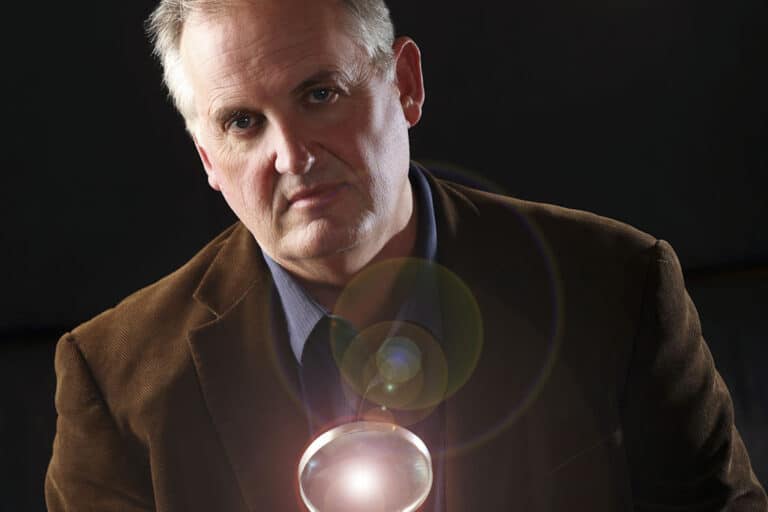
WORDS: Peter Gleeson PHOTOGRAPHY Brian Usher - www.usherusher.com
WHEN Gold Walkley award-winning journalist Hedley Thomas began looking closely at the Shandee Blackburn murder, he knew something wasn’t quite right.
Crucial blood sampling conducted by police had drawn a blank in the Queensland Government’s DNA testing laboratory, despite overwhelming evidence of a frenzied attack with wide blood spatter and a strong chance that the alleged killer’s DNA was linked to the crime.
Smelling a rat, Thomas enlisted the help of eminent forensic scientist Dr Kirsty Wright to help him unravel the mystery.
The rest, as they say, is history, befitting a real-life Netflix crime drama. The more Thomas probed, the more it seemed like the Shandee Blackburn killing was a clear and unequivocal miscarriage of justice.
But as much as this was a pursuit of justice for the Blackburn family, a much bigger, more sinister outcome was emerging. The implications of a shoddy, lazy, incompetent bureaucracy and scientific basket case at the lab, formerly known as the John Tonge Centre, has rocked the Queensland criminal justice system.
Killers and rapists got off because the lab failed to find their DNA, which was always there at crime scenes; and some men convicted for treacherous crimes may have been innocent.
As she read through hundreds of pages of documents from Shandee’s case before a single episode was published, an increasingly alarmed Dr Wright told Thomas that the Blackburn case – and its obvious DNA flaws – was just the tip of the iceberg.
The government-run DNA lab charged with the task of linking – or clearing – blood samples to crime scenes was a mess, a victim of its own hubris, incompetence and cavalier regard for justice.
Thomas, through his award-winning podcast Shandee’s Story, and Dr Wright had uncovered one of the biggest disasters and cover-ups in Queensland’s criminal justice history.
Hundreds, if not thousands, of criminal cases had been compromised by a systemic failure of the DNA lab to do its job to best practice standards.
Thomas’ revelations led to an inquiry chaired by Walter Sofronoff, KC, who savaged the DNA lab and recommended wholesale changes, which the government has pledged to enact.
Thomas and Wright appeared together at a recent Somerset College-Storyful lunch at Royal Pines, where they detailed the litany of lies and obfuscation that preceded the launch of the inquiry.
For Thomas, the Blackburn investigation netted him another Walkley, his eighth, as well as the Graham Perkin Journalist of the Year Award. In 2022, he also won News Corp’s highest honour, the Sir Keith Murdoch Award, for the third time.
It came just two years after he had launched The Teacher’s Pet podcast, which led to the conviction and jailing of Chris Dawson for the murder of his wife Lynette in 1982.
For somebody with the investigative skills of a top-tier detective, the empathy of Mother Theresa and writing skills without peer, Thomas has come from humble beginnings.
He likes a beer and a bet, and a round of golf, and his love for his family is only matched by an insatiable appetite for uncovering the truth.
Thomas has been shot at, mauled by criminal defence lawyers and targeted by spin doctors desperately trying to undermine his investigative journalism.
He never takes a backward step. If he believes there’s been an injustice, it’s game on.
Thomas’ finely honed instincts to sniff out a big story can be traced back to his upbringing on the Gold Coast during the 1980s, a fertile haven for observing crooks, spivs and “colourful racing identities’’.
As the cabbies would often say – welcome to the Gold Coast, where the sun shines on the shady.
It was this sixth sense for detecting a rort, an innate ability to sort the wheat from the chaff that has led to Thomas’s glittering career.
The fact that Thomas himself is somewhat of a knockabout, having been going to the races since he could jump the fence as a teenager, is also a testament to his ability to work out who’s who in the zoo.
Growing up on the Gold Coast during the 1980s – and subsequently starting as a cadet reporter at the Gold Coast Bulletin in 1985 – was a wonderful apprenticeship for the man now universally acknowledged as one of Australia’s finest investigative reporters.
Thomas, 55, fondly remembers those days as a teenager when he and a few mates would surf after school and head to the greyhounds at night, at the old track in Queen Street, now home to the Southport Tigers footy club.
They’d be there most Friday nights, parlaying up their hard-earned cash from working at McDonald’s and doing milk and paper runs.
One summer evening, they’d had a particularly good night, and it was one of the crew’s 17th birthday.
“We had a lot of money on us for 16-year-olds, particularly when the legal betting age was 18,’’ Thomas recalls.
“It was our good friend’s birthday so after the dogs finished, we decided to head into Surfers Paradise to have a late dinner at a Chinese restaurant and celebrate with a few bottles of Passion Pop, and some vodka and orange.
“It’s 1984 and we each had more than $1000 in winnings in cash, in an unregistered car being driven by a 16-year-old without a driver’s licence. Foolishly, we stopped near the Southport Yacht Club to have a puff on the old whacky tobacco. You can picture the scene — now the car is heading south along Main Beach Parade filled with illicit smoke — and we’re giggling like Cheech and Chong.
“It didn’t take long for the boys in blue to pull us over near Narrowneck. “Naturally, the young constable smelt the smoke in the car and then discovered we had pockets filled with cash.
“We told them we’d been to the Southport dogs and won it. We’re still great friends almost 40 years later and we catch up in Main Beach for a beer and a laugh. To this day, we’re baffled that after taking down our details and telling our parents what we’d been up to, the young constable let us keep our winnings.’’
Soon Thomas would be at murder and serious crime scenes and down at court in Southport, reporting on young men who’d fallen foul of the law.
After a brief stint as a copyboy, the former Keebra Park High student was handed a cadetship and posted to police rounds, the engine room of any newspaper.
Thomas soon became known as “young scanner-man’’, because everywhere he went he had a police scanner and radio to hear what police were doing. He slept with the brick-sized device so that he would be alerted to any crime at an ungodly hour.
If there was a murder, Thomas was the first there. A bad car crash, Thomas was there.
He quickly rose through the ranks and was snapped up by The Courier Mail. Again, he showed his skills as a police reporter.
Thomas was then posted to London, at 22 News Corp’s youngest ever London correspondent and one of his first assignments in Europe was on November 9, 1989, when the Berlin wall came down.
Back then, the late Roy “Rocky’’ Miller, who went on to be managing director of the Gold Coast Bulletin, was editor of the Daily Mirror in Sydney.
An ideas man, he got on the phone to Thomas and asked him to get a slab of the Berlin Wall, send it back to Australia and he’d do a giveaway promotion.
“Win a piece of the Berlin Wall’’, was the front page promo. Thomas didn’t know whether Miller was fair dinkum or not, but after a few phone calls, he realised Miller was serious.
Thomas was young enough and brazen enough to follow Miller’s orders to a tee. He organised a gang of shady West Berliners to go to a remote area and cut out a big piece of the Berlin Wall and Miller ran the wildly successful promo. To this day, he doesn’t know how they pulled it off.
It was during his early days at the Gold Coast Bulletin that Thomas forged a lifelong bond with Paul Whittaker, a former TSS student who is now the CEO of Sky News. They shared a flat together opposite St Hilda’s and stayed up late most nights comparing yarns and talking about who got the better scoop.
Whittaker went on to marry Thomas’ sister Kate, and their passion for racing and tennis has never waned. Thomas’s other sister is Rebecca Frizelle, Titans co-owner and chair, among other luminary posts.
It was under Whittaker’s stewardship as editor-in-chief of The Australian in 2017 that the hugely successful podcast, The Teacher’s Pet, was commissioned.
The rest, of course, is history. Thomas shone a light on a flawed original police investigation after Lyn Dawson vanished in January 1982.
His extraordinary investigative skills helped expose Chris Dawson, Lyn’s husband, as a philandering killer and he was found guilty by Justice Ian Harrison in August 2022.
At 74, the former football star will now die in jail. Thomas is working on a book about the case and an international drama series is now likely.
For Thomas, whose Brisbane home was shot up in 2002 after he got too close to a story that would expose a property fraudster, it’s been a long and at times, difficult road.
He has never shied from the big story, regardless of the personal risks. He won a Gold Walkley for his expose on the wronged prosecution of Indian doctor, Mohamed Haneef.
He helped to bring down rogue surgeon Jayant Patel. The evolution of journalism and the emergence of the long-form podcast has also become an integral part of the way to explain a big story. Journalism is about storytelling, whether it’s in the printed paper, online or through the podcast.
When Thomas started his journalism career, typewriters had just been replaced by old Coyote computers.
It was the era on the Gold Coast when the first Coolangatta Gold event was held, the art gallery and Carrara Stadium opened, and a legitimate casino at Broadbeach was replacing the illegal ones which Thomas and his mates were known to visit in their teens.
Bond University was launched, as was Australia Fair. Movie World opened, as the city’s population surged past 300,000 (it’s now near 700,000).
Denis Pie was Mayor, succeeded by Lex Bell. Tiki Village in Surfers Paradise was the number one spot for end of year footy tours. Sizzler at Mermaid was popular. Meter Maids were known around the world.
It was not just a surfer’s paradise, but a reporter’s dream. There were stories everywhere. Dodgy developers, seedy underworld figures, rampant crime (nothing’s changed).
The one thing we can take from Thomas’ wonderful career is that quality journalism is a cornerstone of The Fourth Estate.
He exposed a corpulent police culture in NSW in the early 1980s that through laziness, or incompetence, did not provide justice for Lyn Dawson and her family members. Similarly, he has done the same with the Shandee Blackburn tragedy, but this time the spotlight has been on a laboratory and the science of DNA.
Courage under fire is a clichéd term but it exemplifies the Hedley Thomas story.


